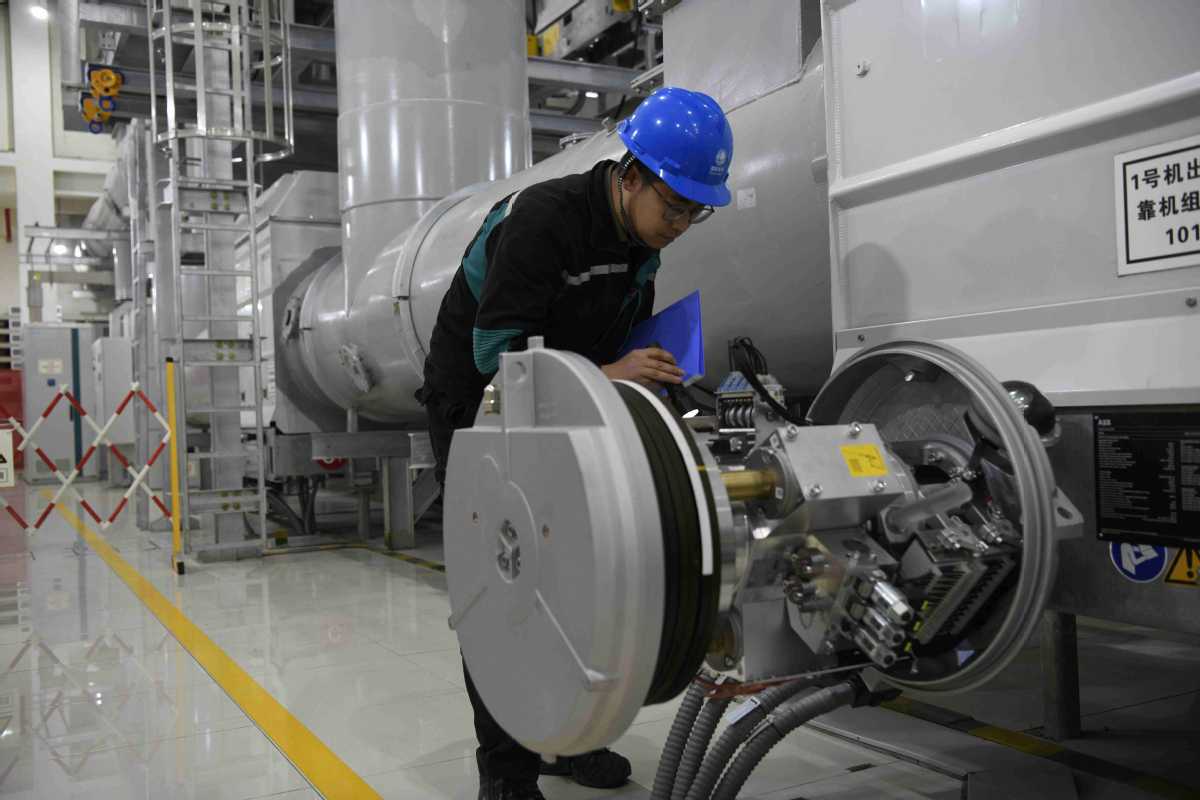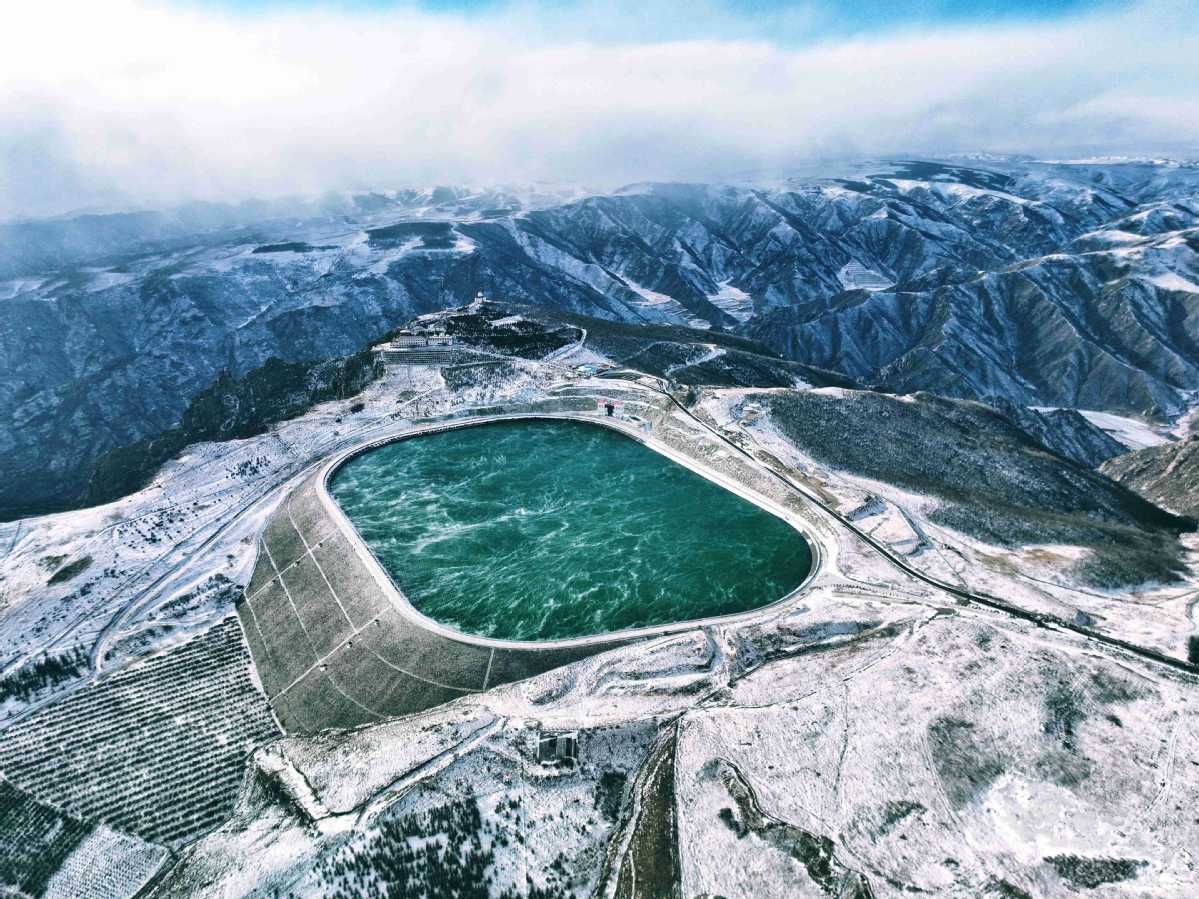An aerial view of a pumped storage hydropower station in Hohhot, Inner Mongolia autonomous region, in January. [Photo provided to China Daily]
Pumped storage hydroelectric stations come as boon to satisfy growing demand.
In late June, as a tunnel gate gradually closed, the upper reservoir of a pumped storage hydropower station in Zhejiang province began storing water for the first time. It is now ready to serve as a "super power bank" for nearby regions.
The same day, the construction officially began on a 1 million-kilowatt pumped storage hydropower project in Chongqing, the first of its kind amid the rocky limestone topography.
Three other pumped storage hydropower projects in Guangdong, Shanxi and Jiangsu provinces also received approvals for construction in June.
All these developments signal the final approvals for 100 million kilowatts of pumped storage hydropower capacity during the 14th Five-Year Plan (2021-25) period, bringing China a step closer toward its decarbonization goals.
The country's power storage industry has experienced explosive growth since 2021, as a series of large-scale, high-technology pumped storage hydropower stations have been made ready or have already started operating.
Approved as well as commissioned capacities hit record highs last year, said the National Energy Administration.
Projects such as the Yangjiang Pumped Storage Hydropower Station with a 700-meter ultrahigh water head and a single unit capacity of 400,000 kW, and the Changlongshan Pumped Storage Hydropower Station with the highest water head in China (756 meters) have begun operations.
Experts say this is a significant leap in the industry's technological level.
Unlike conventional hydropower plants, pumped storage hydropower stations serve as both power generators and consumers. Such facilities have two water reservoirs at different elevations. They pump water from the lower reservoir to the upper level when there is excess power on the grid, and release water to let it flow back downhill to generate power when there is greater demand for electricity.
This has earned pumped storage hydropower stations the nickname "super power banks".
As massive electricity is difficult to store in other ways, the stations help ensure safe and stable operation of the power system, especially after a large batch of intermittent, unstable new energies are used for power generation, experts said.
Xiong Minfeng, deputy head of the new energy and renewable energy bureau at the NEA, said China approved 48 pumped storage hydropower projects with an installed capacity of 68.9 million kW in 2022, surpassing the total approved capacity during the 13th Five-Year Plan (2016-20) period.
The total newly commissioned capacity reached 8.8 million kW last year — a record.
By the end of 2022, China's planned pumped storage hydropower sites had a total resource capacity of about 823 million kW.Among them, 45.79 million kW had already been built, and 121 million kW were under construction, according to a report jointly released by the China Renewable Energy Engineering Institute and the pumped storage hydropower branch of the China Society for Hydropower Engineering.

A technician with State Grid Corp of China inspects hydroelectric equipment at a power facility in Chengde, Hebei province, in May. [Photo/Xinhua]
Zhao Zenghai, deputy head of the institute, said the pumped storage hydropower industry has entered a new phase, characterized by a diverse range of consumers and innovative business models.
"Pumped storage hydropower stations play a significant role in ensuring stable electricity supply and facilitating the green transition of the energy industry. To promote high-quality development in the pumped storage hydropower sector, more efforts are needed for strengthened project management, demand-oriented project planning, and the standardization of new project regulations," Zhao said.
Stepped-up efforts in technological innovation are also expected in areas such as preliminary surveys, facility manufacturing, research and development, digitalization, and environmental conservation, Zhao added.
Li Sheng, head of the institute, estimated that China will have around 62 million kW of operational pumped storage hydropower capacity by 2025.
By 2030, China's operational pumped storage hydropower stations are expected to reach a total installed capacity of about 160-180 million kW.
Experts said China's urgency in achieving its green goals and its strong policy support have driven the rapid development of the pumped storage hydropower industry.
According to data from the NEA, as of end-June, the installed capacity of renewable energy reached over 1.32 billion kW, accounting for about 48.8 percent of the nation's total power generation capacity. Major wind and solar power projects across the country are progressing steadily, with plans to be fully operational and connected to the grid by the end of the year.
"Currently, we are in a crucial period of energy transformation toward green and low-carbon development. The significant growth of new energy sources such as wind and solar power has resulted in a substantial increase in demand for flexible regulation and energy storage capabilities in new power systems," Li said.
"Pumped storage hydropower stations offer various functionalities such as load balancing, energy storage, frequency regulation and contingency backup. They are flexible in operation, quick to respond, possess strong load balancing capabilities, and are cost-effective, which make the stations an important part of the construction of a new power system amid energy transition," he said.
"Furthermore, the improvement of pricing mechanisms for power generated from pumped storage hydropower facilities has injected strong impetus into the accelerated development of the industry," Li added.
In May, the National Development and Reform Commission, the country's top economic regulator, issued a notice regarding the pricing mechanism of electricity generated from pumped storage hydropower stations. This provided price references for 48 pumped storage hydropower stations that were in operation or planned to be commissioned by the end of 2025. Prior to this, in April 2021, the NDRC issued relevant views to improve the pricing mechanism for pumped storage hydropower.
The diversification of investment entities has also stimulated market vitality, according to Li.
In the past, pumped storage hydropower stations were primarily constructed and managed by State-owned grid companies such as State Grid Corp of China and China Southern Power Grid. However, since 2014, a diversified market-oriented investment mechanism that incorporates private capital has been gradually established, experts said
By 2022, traditional power generation companies such as China Three Gorges Corp, Power Construction Corp of China and State Power Investment Corp Ltd, as well as local enterprises like Hangzhou Iron and Steel Group Co Ltd, have entered the field of pumped storage hydropower construction, significantly enhancing the industry's investment capacity.
However, various challenges have emerged along with the rapid growth of the industry. "Some regions overly emphasized the role of pumped storage hydropower in promoting local economic development, leading to proposals for large-scale projects that exceeded reasonable local demand, which may result in investment waste and other unfavorable consequences," Zhao of the China Renewable Energy Engineering Institute said.
Xiong of the NEA said the administration is currently conducting project evaluations to manage expectations of development, and optimizing the layout of pumped storage hydropower stations to promote rapid and sustainable development of the industry.
Source: By Liu Yukun, China Daily, chinadaily.com, Aug 01, 2023 [https://global.chinadaily.com.cn/a/202308/01/WS64c85997a31035260b81996e_2.html]


